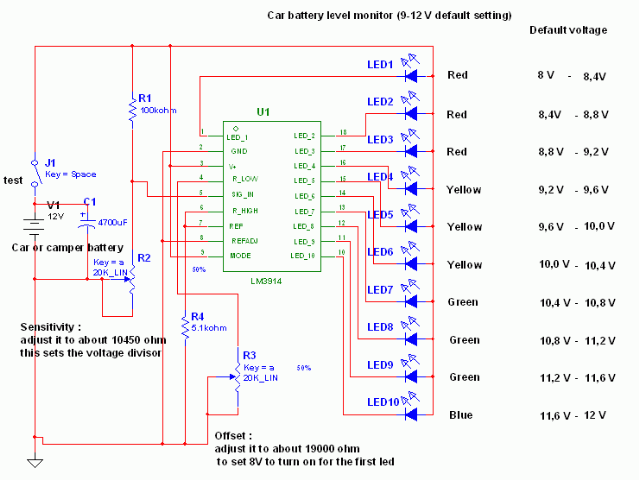


Some applicants may receive a higher or lower regular annual rate depending on a credit evaluation. Offer subject to change without notice.Īdditional information for residents of Quebec only: The regular annual rate for persons applying for the Triangle Mastercard and the Triangle World Elite Mastercard is 22.99% for cash transactions and related fees and 20.99% for all other charges. Any unpaid portion not received by the due date will no longer form part of the equal payments plan and interest will accrue on that amount from the day after the date of your next statement at the applicable regular annual rate.
BATTERY TESTER FULL
Each month during an equal payments plan you are required to pay in full by the due date that month’s equal payments plan instalment. There is no administration fee charged for entering into a special payments plan. However, if we do not receive the full minimum due on a statement within 59 days of the date of that statement, or any event of default (other than a payment default) occurs under your Cardmember Agreement, all special payment plans on your account will terminate and (i) you will then be charged interest on the balances outstanding on such plans at the applicable regular annual rate from the day after the date of your next statement, and (ii) the balances outstanding will form part of the balance due on that statement. Interest does not accrue during the period of the plan. Dealers may sell for less.įinancing available is “Equal payments, no interest” for 24 months (unless otherwise stated) and is only available on request, on approved credit and on purchases of $150 (unless otherwise stated) or more (Gift Cards excluded) made with your Triangle credit card at Canadian Tire, Sport Chek, Mark’s, L’Équipeur, Atmosphere, Sports Rousseau, Hockey Experts, L’Entrepôt du Hockey and participating Sports Experts.

**Online prices and sale effective dates may differ from those in-store and may vary by region. ±Was price reflects the last national regular price this product was sold for. The tire producer / manufacturer and Canadian Tire uses this fee to pay for the collection, transportation, and processing of used tires.ĬANADIAN TIRE® and the CANADIAN TIRE Triangle Design are registered trade-marks of Canadian Tire Corporation, Limited. While on the topic, an unknown VU meter (and/or any galvanometer-based meter in general) can be scoped using a source of steady low voltage dc and a suitable potentiometer in series.△The tire producer / manufacturer of the tires you are buying, and Canadian Tire is responsible for the recycling fee that is included in your invoice. The exact value of the resistors is probably not critical as the dial is relative and small errors are unlikely to be noticed by most end users (naturally, the movement is not exactly linear with respect to voltage, and it’s probably related to spring tension difference across the dial). Of course, this do-it-yourself battery tester too is basically a d’Arsonval meter with an appropriate voltage divider, and a load resistor to allow for the bleeding of surface voltage from the battery to see the voltage under load. And then carefully remove the dial to replace it with a piece of paper with a custom-made battery level scale on it (the dial drawing needs some serious homework). Now see, you can take apart the VU meter by removing two pieces of adhesive tape used to secure its casing. The 10Ω/0.5W load resistor is enough to bleed off surface charge and provide a more accurate indication of remaining battery power compared to reading the open state voltage. Note, the tester draws about 150mA (excluding the display part) because of its 10Ω load resistor (R2) on the 1.5V input. This will give you a range of 470-1470Ω, so plug in a dc source with known output voltage and adjust the trimpot until you get the needle where you want it.
BATTERY TESTER SERIES
Using Ohm’s law, you can calculate that to get voltage of 2V (for 1.5V test) to deflect the needle to the maximum range of the milliammeter (2mA) you need a 1KΩ resistor in series with the meter (2.0V/0.002A =1000Ω).ĭepending on what resistors you might have handy, you can select something like a 470Ω fixed resistor (R1) and a 1KΩ multiturn trimpot (RP1). Simply, it all depends on what kind of meter you use to show the battery level.įor example, let say you’ve a VU meter (milliammeter) with a sensitivity of 2mA. Probably the only thing that may need explanation is the values of the resistors R1 & RP1 on this schematic.


 0 kommentar(er)
0 kommentar(er)
